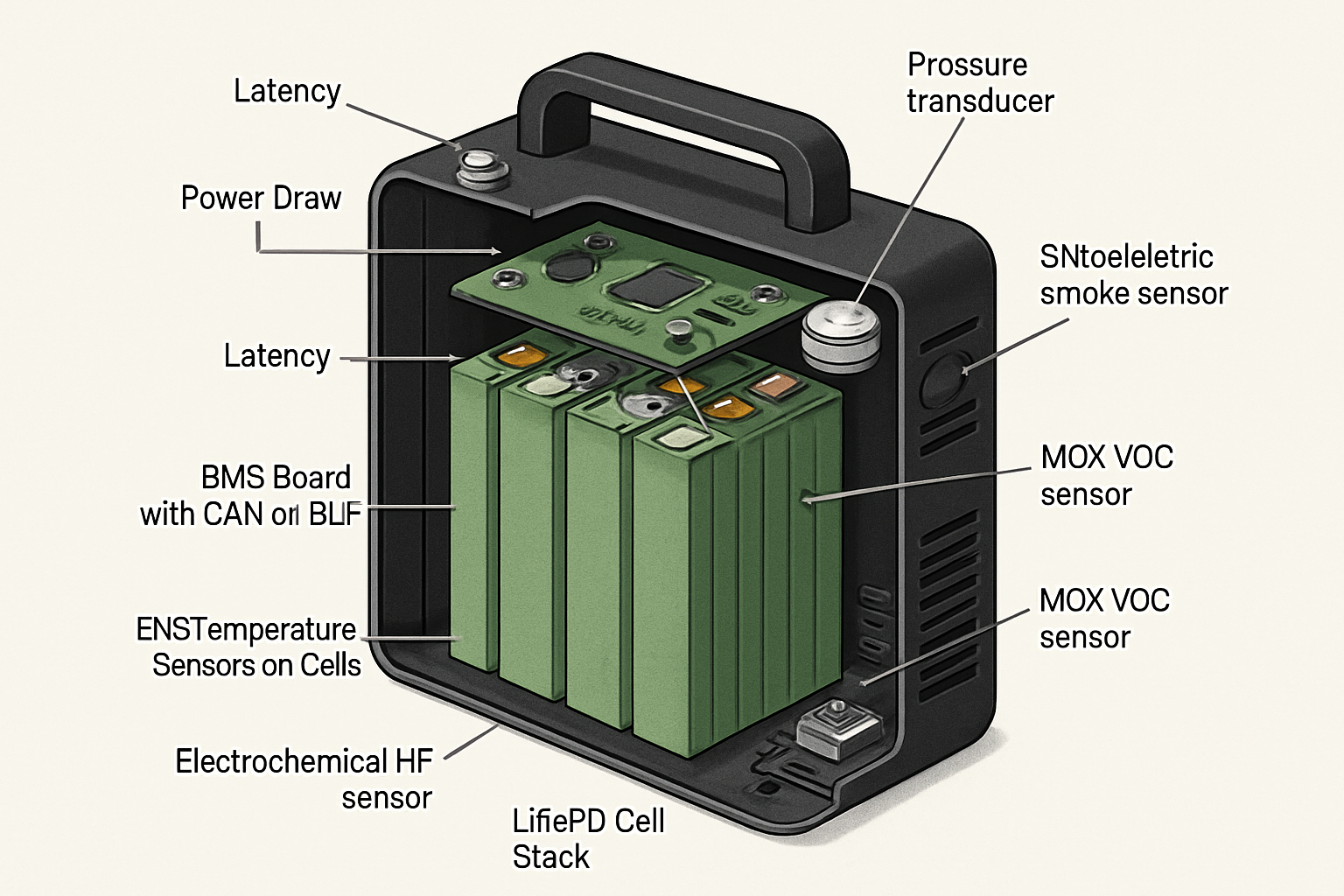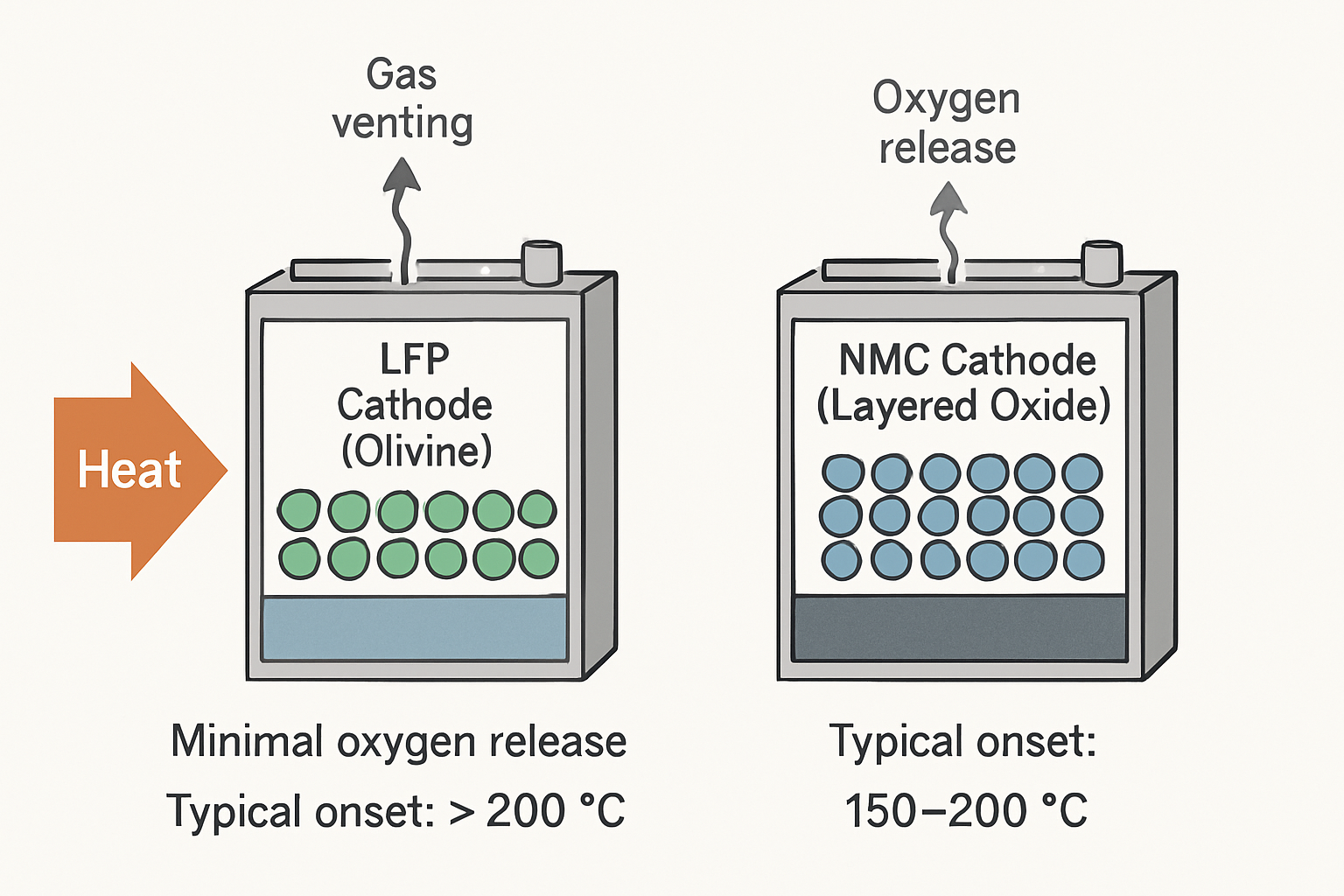Topic: Fire Safety & Lithium Handling
Are portable lithium batteries safe outside? In many cases, yes. Safety depends on chemistry, enclosure, temperature, moisture, and how you operate the pack. I have tested dozens of units on patios, farms, campsites, and rooftops. The data is clear: good design and cautious use lower risk dramatically.

The short, practical answer
You can use portable lithium batteries outside if you control heat, moisture, and charging. Choose a chemistry with a safer fire profile (often LFP). Keep the unit shaded and dry. Charge within the recommended temperature window. Confirm the ingress protection (IP) rating, and check safety labels and test marks. Build in detection and a clear shutdown plan. Follow local codes.
What the outdoors throws at batteries
Outdoor use stresses packs in ways a living room never will. Here is what actually matters and the numbers I see in field work.
- Radiant heat: dark enclosures in direct sun can run 15–25°C above ambient. At 35°C ambient, a black case can reach ~55–60°C on the surface within an hour. Internal cell temps track lower, but still rise.
- Cold charging: most lithium cells risk plating below 0°C if charged at normal current. That damage can be permanent and raises fire risk later.
- Moisture: rain is obvious; dew is sneaky. Condensation after sunset wets seams and connectors and can bridge contacts.
- Dust and salt: conductive grime can track across PCBs and terminals. Salt fog accelerates corrosion.
- Mechanical stress: drops, vibration on vehicles, and cable strain cause internal damage that may not show up right away.
Policy and market context also shape safe deployment. As noted by IRENA, permitting and siting now weigh fire codes and public acceptance. Safer chemistries and enclosures reduce friction for outdoor use. IEA reports highlight chemistry choices: LFP tends to offer inherent safety advantages, while NMC brings higher energy density and different risk tradeoffs. And IEA’s State of Energy Innovation notes solid-state cells are advancing, yet real-world safety advantages still need broad proof at scale.
Myth vs reality: outdoor lithium safety
Myth: An IP67 badge makes outdoor use foolproof
Reality: IP67 means dust-tight and immersion at 1 m for 30 minutes in a lab test. It does not guarantee long-term rain, UV, or thermal cycling endurance. Gaskets age. Connectors and vents are common leak points. For frequent rain or washdowns, elevate the unit, add drip loops, and keep it under a roof or hood. Re-grease seals and check strain reliefs each season.
Myth: All lithium chemistries carry the same fire risk
Reality: Safety differs. LFP often shows a more tolerant fire profile than many nickel-rich blends at abuse conditions, which aligns with the safety notes in IRENA’s cost and technology review and the chemistry tradeoffs discussed by the IEA. Chemistry alone does not decide safety. BMS limits, pack layout, and enclosure design matter just as much.
Myth: Shade alone solves heat
Reality: Shade helps, but hot air still heats the pack. Ventilation, reflective surfaces, and standoffs reduce heat soak. I often see a 5–10°C internal rise on a shaded patio at 35°C ambient during charging. Limit charge current and raise over‑temperature cutoffs conservatively, not aggressively.
Myth: Cold weather is fine if you do not discharge hard
Reality: Discharge at low temperatures is usually okay with reduced power. Charging is the risk point. Below 0°C, charge slowly or use a pack with pre-heat. Many BMS units block charging near 0–5°C to protect the cells. Keep that block enabled.
Myth: Transport tests equal outdoor safety
Reality: UN 38.3 proves a pack can handle shipping shocks, altitude, and thermal cycles. It does not cover years of UV exposure, pooling water, or daily dew. You still need the right IP rating and outdoor operations policy.
Numbers that matter outdoors
| Parameter | LFP portable pack (typical) | NMC portable pack (typical) | Notes |
|---|---|---|---|
| Charge temp range | 0–45°C | 0–45°C | Below 0°C, many BMS block charge to avoid plating |
| Discharge temp range | −20–60°C | −20–60°C | Power may derate near limits |
| IP rating for rain | IP65–IP67 | IP54–IP67 | IP65 blocks water jets; IP67 allows short immersion |
| Direct sun surface rise | +15–25°C vs ambient | +15–25°C vs ambient | Dark cases heat faster; reflective covers help |
| Storage SoC for heat | 30–50% | 30–50% | Lowers stress and fire load in summer |
These are common vendor ranges and field values. Always follow your pack’s label and manual. For context on chemistry trends and safety innovation, see the IEA energy innovation report.
Set up an outdoor-safe portable pack
Site and enclosure
- Keep off bare ground. Use a non‑combustible, raised platform with drainage.
- Provide shade and airflow. A vented weather hood or awning works well.
- Maintain clearance from combustibles. Follow the manual; many call for 20–50 cm. I pick 30 cm minimum on all sides outdoors.
- Use light-colored or reflective covers. Avoid dark fabrics that trap heat.
Moisture control
- Confirm IP rating. For rain exposure, aim for IP65 or higher.
- Route cables with drip loops. Seal unused ports with caps.
- Add desiccant packs inside accessory boxes, not inside the battery case.
- After heavy dew or spray, dry surfaces and connectors before charging.
Charging and BMS
- Respect charge temperature limits. If ambient is near 45°C, reduce current.
- In cold conditions, pre‑heat or wait until pack exceeds 5°C to charge.
- Leave BMS protections enabled: high/low temp, pack over‑current, cell UV/OV.
- Set SoC targets for seasons: 80–90% in cool weather; 50–70% during hot spells.
Cables and protection
- Use outdoor‑rated AC outlets with GFCI/RCD where required.
- Protect DC connectors from splash and strain. Lock them if the unit supports it.
- Inspect for nicks, hot spots, and corrosion every month of outdoor use.
Chemistry choices and why they affect outdoor risk
LFP packs are popular for portable use because the cathode is less oxygen‑rich. That usually reduces fire severity under abuse. This aligns with technology comparisons cited by IRENA and material risk notes in the IEA critical minerals report. NMC packs offer higher energy density, which can matter for weight-sensitive camping or film crews. If you choose NMC, pay extra attention to thermal limits and shade.
Solid-state and new electrolytes aim to cut flammability. The IEA innovation report points out that many of these are still maturing. For outdoor users today, robust BMS and mechanical design still carry the safety load.
Regulations, labels, and outdoor claims
Look for evidence, not marketing terms. Real labels and documents include:
- UN 38.3 test summary for transport.
- IEC 62133 or equivalent safety certification for cells and packs.
- Ingress Protection (IP) rating for dust/water exposure.
- Material ratings on the enclosure (e.g., UV resistance, flame class) and clear vent paths.
Policy trends signal tighter scrutiny. IRENA notes that siting and fire codes are increasingly part of storage deployment. The EIA and the U.S. DOE solar energy portal provide context and safety resources for storage paired with solar. Expect more emphasis on transparent labeling and traceability as supply chains expand, a theme echoed across recent IEA investment analysis.
Non-legal advice: standards and codes vary by country and region. Confirm local requirements with your authority having jurisdiction.
Field snapshot: hot patio in midsummer
Ambient 38°C, light breeze. A 1 kWh LFP unit under a white canopy charged at 0.3C. Surface sat near 50–52°C. Internal sensors peaked at 46°C. Dropping charge current to 0.2C and adding a reflective blanket reduced internal temperature to 41–42°C. That kept the pack within the typical 45°C charge cap, with margin.
Key takeaways you can use today
- Pick LFP if safety and longevity matter more than compact size.
- Demand IP65+ for rain, and still use a roof or hood.
- Keep shade and airflow. Avoid sealed boxes that trap heat.
- Charge within 0–45°C. In heat waves, lower current and stop early.
- After wet exposure, dry and inspect connectors before charging.
- Store at 30–50% SoC during hot seasons. Do monthly checks.
References
- IRENA. Renewable Power Generation Costs in 2024 (2025). Notes on permitting, siting, and safety context for storage deployments. https://www.irena.org/Publications/2025/Jun/Renewable-Power-Generation-Costs-in-2024
- IEA. The Role of Critical Minerals in Clean Energy Transitions (2021). Chemistry tradeoffs and electrolyte research toward lower flammability. https://www.iea.org/reports/the-role-of-critical-minerals-in-clean-energy-transitions
- IEA. The State of Energy Innovation (2025). Status of solid-state and safety‑relevant advances. https://www.iea.org/reports/the-state-of-energy-innovation
- IEA. World Energy Investment 2023 (2023). Supply chain and investment trends shaping battery availability and scrutiny. https://www.iea.org/reports/world-energy-investment-2023
- U.S. DOE. Solar Energy topic hub. General resources on solar‑plus‑storage safety and deployment. https://www.energy.gov/topics/solar-energy





Leave a comment
All comments are moderated before being published.
This site is protected by hCaptcha and the hCaptcha Privacy Policy and Terms of Service apply.